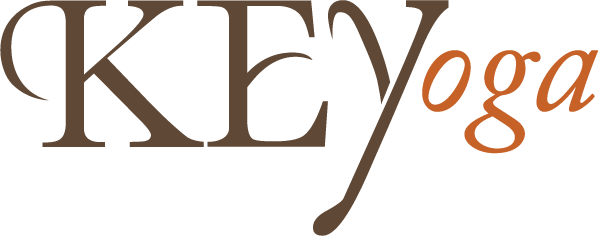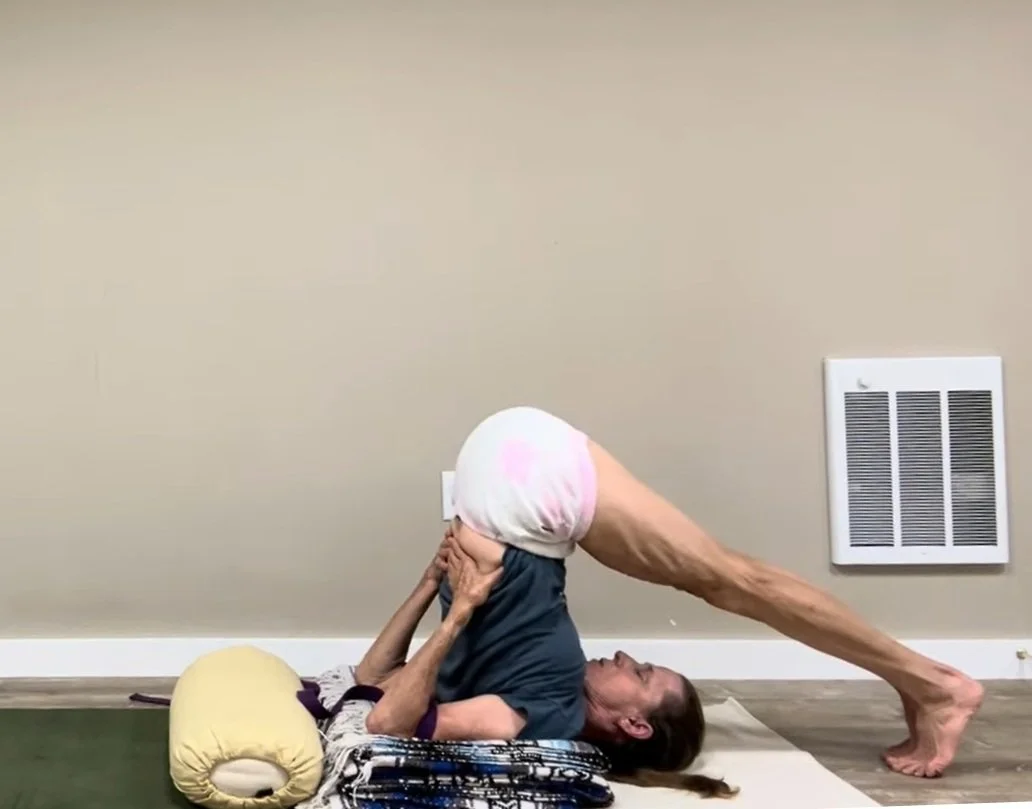Kurmasana is a deep forward bend with the arms pinned under the thighs.
Kurmasana or Tortoise Pose
In this practice I start with a T-Shaped version of Supta Virasana with the knees raised on a rolled balnket and a bolster under the hips, torso and shoulders. The arms are stretched overhead in Baddha Hastasana. The quad stretch prepares for the next pose which is Virabhadrasana II. The quadriceps and the psoas need to be lengthened and loose for this lateral pose.
Supta Virasana on t- shaped props
The arms clasped overhead will show up later in this sequence when we do Parivrtta Upavistha Konasana. But, the thigh stretch will help us in the next pose: Virabhadrasana II
Virabhadrasana II
Virabhadrasana II opens the hips and stretches the thighs. The fact that the back quadricep was stretched in Supta Virasana helps us to bend the front leg deeply in this pose.
Next comes Utthita Parsva Konasana with the bottom arm inside the front leg. This helps by using leverage between the arm and the thigh to turn the chest up towards the ceiling. We will need that for Parivrtta Upavistha Konasana.
Utthita Parsva Konasana
Utthita Parsva Konasana with Arms in Baddha Hastasana
Can you see the similarities in the stretch from Supta Virasana and the right side of my body In Parsva Konasana when I take my arms overhead into Baddha Hastasana in the second photo?
Next is Prasarita Padottanasana (Wide Legged Forward Bend). It is a preparation for Sirsasana
Sirsasana
Konasana in Sirsasana
Baddha Konasana in Sirsasana
Samakonasana in Sirsasana
I do three variations in Sirsasana: Konasana (Wide Legs), Samakonasana (Wide Legs, turned out) and Baddha Konasana (Cobbler’s Pose).
Then we do Lizard Lunge. See how my back leg is supported on two blocks? This is the same quadricep stretch from our first pose; Supta Virasana. Now we are working on getting the hips to flex deeply so we can get the shoulder to duck under the thigh.
After Lizard Lunge I throw an arm balance in there; Dwi Hasta Bhujasana (Two Leg Arm Pressure Pose). All of this work towards getting the arm inside of the front leg is necessary for this arm balance.
Dwi Hasta Bhujasana
Next we do Upavistha Konasana. It is a deep forward bend extending the chest to the floor between the stretched out legs.
Upavishta Konasana
Then we do Parivrtta Upavistha Konasana. Can you see how the torso is stretched in a similar way to our first pose: Supta Virasana? The arms are also overhead, helping to elongate the torso. The arms help turn the torso as they did in Parsva Konasana.
Parivrtta Upavistha Konasana
Now we are ready for Kurmasana. It is a deeper forward bend than Upavistha Konasana. See how the arms are under the thighs?
Kurmasana
We finish in Sarvangasana with variations: Halasana, Supta Konasana, Parsva Halasana and Karnapidasana before settling into Supta Baddha Konasana.
Sarvangasana
Halasana
Supta Konasana
Parsva Halasana
Karnapidasana
Supta Baddha Konasana
Did you like this sequence? Share your experience with me in the comments below.





















